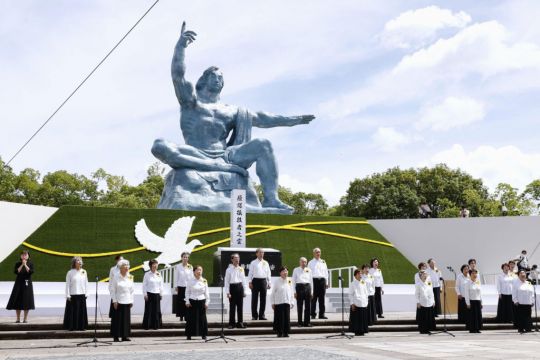Residents of Nagasaki have paid tribute to victims of the US atomic bombing 77 years ago, with the mayor warning Russia’s war on Ukraine showed that another nuclear attack is not just a worry but “a tangible and present crisis”.
Mayor Tomihisa Taue, in his speech on Tuesday at the Nagasaki Peace Park, said nuclear weapons can be used as long as they exist, and their elimination is the only way to save the future of humankind.
Russia’s invasion of Ukraine and threat to use nuclear weapons came only a month after it and four other nuclear powers pledged in a statement that nuclear war should never be fought, Mr Taue said.
“This has shown the world that the use of nuclear weapons is not a groundless fear but a tangible and present crisis,” he said. The belief that nuclear weapons can be possessed not for actual use but for deterrence “is a fantasy, nothing more than a mere hope”, he added.

As in Hiroshima, Russia and its ally Belarus were not invited to the memorial event in Nagasaki.
The United States dropped the world’s first atomic bomb on Hiroshima on August 6 1945, destroying the city and killing 140,000 people.
It dropped a second bomb three days later on Nagasaki, killing another 70,000. Japan surrendered on August 15, ending the Second World War and Japan’s nearly half-century of aggression in Asia.
Participants, including diplomats from nuclear states, observed a moment of silence at 11.02am, the moment the bomb exploded above the southern Japanese city on August 9 1945.
Although Russia last week tried to roll back on Vladimir Putin’s warning, fears of a third atomic bombing have grown amid Russia’s threats of nuclear attack since its war on Ukraine began in February.
Russia last week shelled a Ukrainian city close to Europe’s largest nuclear plant.

Prime Minister Fumio Kishida said: “Even though we face a severe security environment, we must pursue the history of non-nuclear use and make Nagasaki the last place of nuclear attack.”
Japanese officials worry that the conflict may embolden China to be even more assertive in East Asia, and the government is pushing to step up its military capability and spending.
Japan renounces its own possession, production or hosting of nuclear weapons, but as a US ally Japan hosts 50,000 American troops and is protected by the US nuclear umbrella.
However, Russia’s nuclear threat has prompted some hawkish lawmakers in the governing party to raise the possibility of nuclear sharing with the United States.
Mr Taue said discussions about nuclear disarmament and non-proliferation over the past decades have not been put into practice and trust in the 1968 Treaty on the Non-Proliferation of Nuclear Weapons has become “tenuous”.
“We must recognise that ridding ourselves of nuclear weapons is the only realistic way of protecting the Earth and humankind’s future,” Mr Taue said.
He urged Japan’s government to exercise leadership in pursuing peace diplomacy that does not rely on nuclear deterrence.
“Nuclear weapons are not deterrence,” said Takashi Miyata, an 82-year-old survivor, or hibakusha. He said possible nuclear sharing is “the opposite of our wish”.

Air-raid sirens and scenes of bombed-out Ukraine reminded him of the “pika don” or the flash and explosion of the atomic bombing that Mr Miyata experienced at the age of 5. His uncle and aunt died in the bombing, and his father died of leukaemia five years later. Mr Miyata also developed cancer 10 years ago.
Many survivors of the bombings have lasting injuries and illnesses resulting from the explosions and radiation exposure and have faced discrimination in Japan.
As of March, 118,935 survivors are certified as eligible for government medical support, according to the health and welfare ministry. Their average age now exceeds 84.







